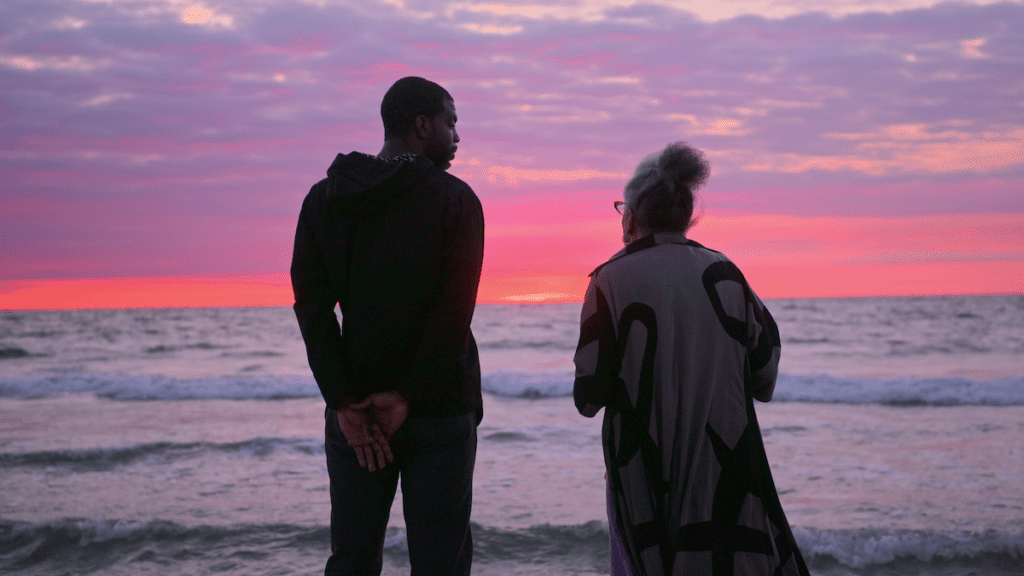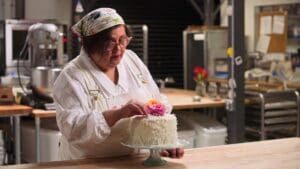After season 2 of ‘High on the Hog,’ there is more to be told
If I got paid every time people ask me what I think about “High on the Hog,” the Netflix series, my Venmo balance would be enough to cover a table full of spinach artichoke dip and rounds of lemon drop martinis. My answer is complex — I’m in community with many characters, locations and unseen references in the culinary world in a way that surpasses familiarity. As a food writer, cookbook author and producer, I have a shorthand about Black American foodways.
In late 2023, “High on the Hog,” the Netflix series based on Dr. Jessica B. Harris’ New York Times bestselling 2011 book of the same name and hosted by Stephen Satterfield, founder of Whetstone media, returned to streaming. In season two, you’ll find feeding troughs full of jumping-off points about civil rights, gentrification, watermelon men and food journalism. The entire series is hearty, a visual storytelling, with both seasons one and two highlighting Black Americans’ contributions to United States food culture and serving as a permanent reference to Harris’ culinary history work. Both the book and visual series have many parallels to “Roots,” which premiered on ABC in 1977, an eight-part miniseries based on the book by Alex Haley that remains a classic featuring the likes of LeVar Burton, Louis Gossett Jr. and the late Cicely Tyson. Both projects are conversation starters for Black Americans to explore their families’ origins and are poised as door-opening juggernauts on culinary reparations. And like “Roots,” “High on the Hog,” too, bears the burden of public critique. The callouts of inaccuracies and missing notable food figures have bubbled up on social media and in private conversations. For some, “High on the Hog” will be the final word for how Black food transformed America’s table or a battle cry for executives to fund more Black food stories on the screen.

In a fast changing media world where I’ve volleyed from being a freelance writer to one of the few Black women to lead a mainstream food publication and back to freelance writer, I understand the difficulties of telling stories in a limited space and squeezing nimble voices and the most powerful ones, too — perfection is impossible. One series can’t be all things to all people, but creating opportunities to build off the success of “High on the Hog” is a crucial next step in the new arsenal of Black food TV. I first watched the episodes out of order, based on what cities I knew the most about — Atlanta, Uptown New York City and Pullman Porter land, and then You Got Next (pet names I gave episodes). This method was a part of studying what viewers would take away from the production; then, I chronologically watched and dissected the most dynamic moments viewers are bound to rewind. Satterfield’s storytelling is more upbeat this time. The cameras capture him holding a notebook surrounded by calming waters and hovering southern trees, maybe as a signifier of his real-life passion for travel and poetry. Viewers see more of Harris in episodes than in season one, in which she appears in only the first episode; she bobs into communal scenes to strengthen the narration, which are most often tidbits from her book. Satterfield’s familial roots become the quilt wrapped around each vignette, while the topics of migration, queerness, ancestors and “passing the torch” slightly mirror Harris’ book.
In the second half of the Great Migration (or Pullman Porter) episode, we eavesdrop on a conversation akin to the tradition of communion in Black barbershops and hair salons, weaving in the lives of seven Black men in a sophisticated way that includes a dialogue on dining, fashion, wanderlust and workplace violence and shows a vulnerability and intimacy rarely seen on TV. Satterfield introduces us to the late Benjamin Gaines Sr., a 99-year former Pullman porter, whose job was attending to sleeping cars and serving lobster salad and boiled beef tongue. He brings me to tears, telling the tale of white supremacy along the grimy tracks of America. Satterfield and Gaines, along with Michael McGoings, son of a Pullman porter, sit down on a train car to share a meal of perfectly cooked rack of lamb prepared by Erick Williams, a James Beard award-winning Chicago restaurateur, of Virtue. “To do that scene, I had to tap into my own family history. I read my grandfather’s obituary. This life was his life,” said Satterfield, whose grandfather worked as a Pullman porter.
In addition to moments of golden-fried food porn, “High on the Hog” teases the intersection of activism and food as pleasure. In the episode titled “The Defiance,” Satterfield goes to his hometown to meet with former Atlanta Student Movement protesters, whose recollections moved my soul so deeply and made me want more, not just chicken from historic Paschal’s restaurant (the original location was a meeting hub for civil rights activists). Satterfield joined Dr. Georgianne Thomas, Marilyn Pryce Hoytt and Charles Black for a meal. As they spoke about organizing while matriculating, their still-visible scars and blinding perseverance took over my screen, captivating me in a way food never will. This pocket of American history needs a full-on feature on how students at the Atlanta University Center (the largest consortium of historically Black colleges and universities in the U.S.) were the catalyst for making Atlanta “the city too busy to hate,” the new center of entertainment, economic advancement and political power for Black Americans. “I was so grateful to honor these elders in this episode,” said Satterfield, who was an executive producer for season two, along with Harris. The next part of the Atlanta episode gives viewers a glimpse into “the Atlanta way” of today, showing the diversity of the modern American South through a visit to a mosque, a look at Black baking traditions, memories of Yasin’s Fish and a conversation about running restaurants with chefs and cookbook authors Erika Council, of Bomb Biscuit Co., and Todd Richards, author of “Roots, Heart, Soul.”

Black intelligentsia, steadfastness, sacrifice, beauty and possibilities permeate every episode of “High on the Hog,” which makes it feel like a swan song, but there is more to be told. “We were praised in the first season for making a food show that didn’t feel like a food show. We are giving our viewers a reasonable and credible benefit of the doubt, based on how they engaged with the storytelling,” said Satterfield. There are omissions and errors: the late Sylvia Woods’ 61-year-old restaurant empire (recently named a James Beard Foundation American Classic); chef Shenarri Freeman of Cadence’s vegan dishes absent from the final scene of the series; chef Alexander Smalls’ incorrect framing of his restaurants as the first Black-owned fine dining establishments in NYC. There’s also a lot of assuming that the viewers know the history of print and online media, including the lack of context around KJ Kearney, creator of Black Food Fridays, and DeVonn Francis, culinary creative and founder of Yardy, bantering about social media in Conde Nast’s Bon Appetit test kitchen. We needed more time for Karen Washington, the godmother of New York City community gardens and urban farming. The series missed the chance to tackle the killing of George Floyd and how the tragedy kicked off the first wave of culinary equity.
When I started to put down words about what viewers should expect to see, a bit of the ideals of Morehouse College ran through my mind, that a crown was placed above my head a long time ago. My assignment is to continue the legacy of Black food storytelling by knocking on the doors of gatekeepers. Confidently, I’m carrying the baton. I bear witness to the beginning of a new dawn — I’ve seen “High on the Hog.”
Get the latest food news, from FoodPrint.
By subscribing to communications from FoodPrint, you are agreeing to receive emails from us. We promise not to email you too often or sell your information.
Top photo: Soupou kanja from chef Serigne Mbaye of Dakar NOLA, in New Orleans. Courtesy of Netflix.
More Reading
Restoring Native foodways requires returning land. What happens when it's contaminated?
June 10, 2025
Big Banana’s bitter labor truths
May 13, 2025
The racist roots of Black land loss
February 25, 2025
Why worker welfare is critical to truly “sustainable” wine production
January 10, 2025
How we came to rely on emergency food
September 30, 2024
Food and farmworkers need protection from heat and other dangers
August 28, 2024
How can ecofeminism help us envision the future of food?
July 18, 2024
A new agritourism network connects and promotes farmers of color
June 11, 2024
The 'unseen hands' of the food system
February 27, 2024
